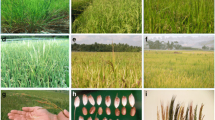Summary
Relative importance of harvest index (I) and total biomass yield (B) to economic yield (Y) was assessed in several food crops at different levels of environmental productivity. Importance of B is generally higher in low than high yielding environments, while that of I is higher in high than low yielding environments. In some crops B is important throughout different yield levels while in others I is important even in low yielding environments.
Past efforts by anonymous farmers have consummated a good part of genetic improvement of crop yields through improvement in B. Many venerable land cultivars of grain crops, adapted to unimproved, limited-input cultural conditions, evolved through this process. The same process may not have thoroughly exhausted the yield improvement opportunity through improving I. Success in yield improvement by modern breeding has been limited mainly to high-input cultural conditions characterized by higher soil fertility and irrigation mainly through improvement in I. Varietal improvement possibility for less productive environments is discussed.
Similar content being viewed by others
References
Buzzell, R.I. & B.R.Buttery, 1977. Soybean harvest index in hillplots. Crop Sci. 17: 968–970.
Chandler, R.F.Jr., 1969. Plant morphology and stand geometry in relation to nitrogen. p. 265–285. In J.D.Eastin, F.A.Haskins, C.Y.Sullivan, C.H.M.vanBavel, and R.C.Dinaver (eds). Physiological aspects of crop yield. Am. Soc. Agron. Madison, Wis.
CIAT, 1975. Annual report, Bean program. Centro Internacional de Agricultura Tropical, Cali, Colombia, P C1–58.
CIAT, 1977. Annual report, Bean program. Centro Internacional de Agricultura Tropical, Cali, Colombia, P B1–85.
CIAT, 1978. Annual report, Bean program. Centro Internacional de Agricultura Tropical, Cali, Colombia, P C1–75.
Donald, C.M. & J.Hamblin, 1976. The bioligical yield and harvest index of cereals as agronomic and plant breeding criteria. Adv. Agr. 28: 361–403.
Duncan, W.G., D.E.McCloud, R.L.McGraw & K.J.Boote, 1978. Physiological aspects of peanut yield improvement. Crop Sci. 18: 1015–1020.
Jennings, P.R. & R.C.Aquino, 1968. Studies on competition in rice III. The mechanism of competition among phenotypes. Evolution 22: 529–542.
Kannenberg, L.W. & R.B.Hunter, 1972. Yielding ability and competitive influence in hybrid mixture of maize. Crop Sci. 12: 274–277.
Kawano, K. & A.Tanaka, 1967. Studies on the competitive ability of rice plant in population. J. Fac. Agr., Hokkaido Univ. Sapporo, Japan 55: 339–362.
Kawano, K., H.Gonzalez & M.Lucena, 1974. Intraspecific competition, competition with weeds, and spacing response in rice. Crop Sci. 14: 841–845.
Kawano, K., PabloDaza, AlvoraAmaya, MarioRios & Wania M.F.Goncalyez, 1978. Evaluation of cassava germplasm for productivity. Crop Sci. 17: 377–380.
Kawano, K. & MichaelThung, 1982. Intergenotypic competition and competition with associated crops in cassava. Crop Sci. 22: 59–63.
Kawano, K. & P.R.Jennings, 1983. Tropical crop breeding—Achievements and challenges. P 81–99. In: Potential productivity of field crops under different environments. Int. Rice Res. Inst., Los Banos, Laguna, Philippines.
McEwan, J.M., 1973. The performance of semi-dwarf wheats in New Zealand: Implications for New Zealand wheat breeding. P 557–559. In: E.R. Sears & L.M.S. Sears (Eds). Proc. Fourth Int. Wheat Genet. Symp., Agric. Exp. Stn., College of Agr., Univ. of Missouri, Colombia, Mo.
Sims, H.H., 1963. Changes in the hay production and the harvest index of Australian oat varieties. Aust. J. Exp. Agric. Anim. Husb. 3: 198–202.
Singh, I.D. & N.C.Stoskopf, 1971. Harvest index in cereals. Agr. J. 63: 224–226.
Syme, J.R., 1970. A high-yielding Mexican semi-dwarf wheat and the relationship of yield to harvest index and other varietal characteristics. Aust. J. Expt. Agric. Anim. Husb. 10: 350–353.
Tanaka, A., K.Kawano & J.Yamaguchi, 1967. Photosynthesis, respiration, and plant type of the tropical rice plants. Int. Rice Res. Inst., Los Banos, Philippines. Tech. Bull. No. 7.
YamaguchiJunichi, 1974. Varietal traits limiting the grain yield of tropical maize. IV. Plant traits and productivity of tropical varieties. Soil Sci. Plt. Nutr. 20: 287–304.
Author information
Authors and Affiliations
Rights and permissions
About this article
Cite this article
Kawano, K. Harvest index and evoluation of major food crop cultivars in the tropics. Euphytica 46, 195–202 (1990). https://doi.org/10.1007/BF00027218
Received:
Accepted:
Issue Date:
DOI: https://doi.org/10.1007/BF00027218




